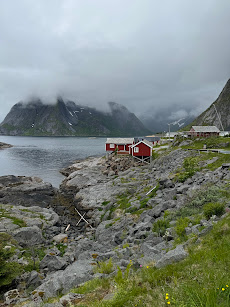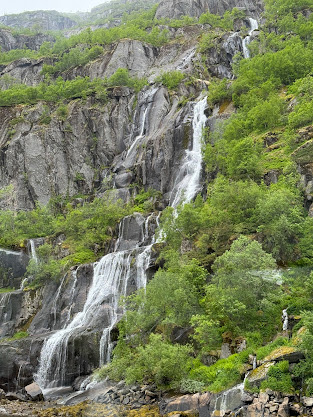Norway: Inntravel Norwegian Highlights holiday begins
Our Norwegian Air flight (Bari - Oslo) was “retard”
so we had a bit of time to kill at the airport. We were planning to catch
the train into Oslo from the airport, but found for today it had been replaced
by a bus. Seems a bit of a theme for us! I inadvertently ended up with four tickets, not two, after the guy in front of me in
the queue abandoned his purchase, now to get my 980 kr
back.
We'd allowed for a day in Oslo in case the Bari flight didn't work. After a productive trip to the nearby Information Centre we spent the day travelling the city by tram, initially visiting Frogner Park with hundreds of sculptures, Gustav Vigeland's life work. He started sculpting the statues in 1907 and finished in 1947.
The pictures do tell the story. All statues are nudes, men, women and children.
They reflect all of life and its joys and struggles; this is a mammoth work,
and the park housing this display is very large and also was designed by the
artist. An impressive amount of work in both metal and stone.
Eating out is a bit confronting
in this part of the world, a simple lunch at a café downtown, coffees, a filled
roll and a small piece of cold quiche, just NZ$41. A couple of Burger King
medium meals all yours for $57. In contrast, the breakfasts provided as part of our accommodation
package are just astounding, beautifully presented options, hot, cold cereal,
bread, juices coffee, cheese fruit, all in unbounded quantities.
Packing and departure were very
easy this time, the train to the airport was running every 10 minutes, and the
railway station just 300m away, then another 200m or so through the station.
The 57 km to the airport took just 20 minutes, and then, it’s all trolleys,
lifts and escalators and happy travellers.
The Norwegian Highlights adventure begins: Lofuten Islands

Oslo airport processing provided a few challenges and it took well over an hour to get through the formalities. The Airbus 320 was packed full for our flight north to Bodo, but the bags were checked through to Svolvaer. The last and most interesting bit of the flight was just 20 minutes in a Dash 8 with Wideroe.
Scandanavia was shaped in the last ice age, and probably the other four prior to that, by up to 3 km deep ice and associated glaciers which carved out fjiords and ground down the granite. So there is a lot of low smooth boulder areas, but still some very steep and jagged mountains, in Norway anyway. We flew over some coastal ground-down areas to land in Svolvaer, with the rough, high, jagged hills all around.
We picked up a rental car and drove just a few kilometres to our accommodation in the small town. The area has been inhabited since Viking times and before, and has been a fishing base for hundreds of years. The main target species is cod, which as the local saying goes is known, like a favourite child, by many names. Cod and Stockfish will do to start. The fish has been caught and dried with the same technique for hundreds of years as these historical pictures show.
The aroma of fish and fish oil pervade parts of the town. The drying racks, very unsophisticated wooden racks are immense. The fish is gutted and then put on these racks, unsalted, from February to May, so almost 80% of the moisture is gone. The dried cod is sent to Mediterranean countries, Croatia and Italy in particular, and the heads to Nigeria.
At the entrance to the harbour there's a rather poignant statue of a fisherman's wife, awaiting his return from the treacherous seas.
Our accommodation is a traditional fisherman’s hut called a rorbu. Ours is quite spacious, because they didn’t have singles available, and we’ve paid extra for the space, but it is nice to have a dressing room when you are travelling. We only come this way once as they say. Our rorbu is the red building on the right of the photo.
The origin of the rorbu, is that Frederik 11 decided to provide them so that the itinerant fishermen had some shelter while they came here to catch the fish that arrive here to spawn in these waters. There was a bit of competition between Church and State for control of the industry and trade, so owning the housing helps.
First day we had arranged for a boat trip out into the fjiords.
A postcard picture captures them much better than my Iphone 15 Pro!! These birds were hunted to endangered status but have been allowed to recover in our more enlightened modern world.
There were a few aquaculture farms set up for Atlantic salmon in the fjords, but we saw little evidence of other fish life, just plenty of fishing boats. The hills around are impressively steep, with a few waterfalls evident, but not the very high cliffs we expect to see on the mainland leg of our trip.
An underwater drone was deployed around one of the many small sea mounts, and we enjoyed a show of the seaweeds, small fish and local starfish, with plenty of reds and pinks in evidence. It was a lovely experience trundling quietly along in a smooth sea being entertained by an informative commentary on the area.
The rest of the day was spent doing a walk around the small town, visiting the very good WW11 museum which has a large amount of display material covering off on Norway‘s part in the second World War. It was particularly interesting because I was certainly aware of some of it, but I came away much better informed.
Our Inntravel package includes quite a few meals at Borsen Spiseri, a top dining spot in Svolvaer and happily for us the restaurant attached to our accommodation. Tonight’s dinner is a three course introduction to the local fare. The entrée, Lofoten flavours, had a crumbed cod and potato ball, a local cheese, caviar and red onion on a cracker, fish roe pancake and smoked whale meat. Ann had local scallops, and we both had a halibut main. Slight variations for the second night, both had the local entrée and a lovely lamb main. Delicious desserts too!
Some will have some difficulty with the whale meat options, Norwegians and Japanese would argue this has been a traditional food here for hundreds of years. We’re happy to join them in a small taste. Ross was the first family member to join the club for this cuisine option. He was in Kobe in 1995 on a Lions exchange programme, and his host introduced him to a meal of whale meat. In Norway 2024 Mum and Dad joined him.
For our second day in Svolvaer we did the drive to the southern tip of the string of Lofoten islands. The bigger islands are joined by bridges and tunnels, and the road goes through some very impressive scenery.
Unfortunately for our trip south there was heavy cloud cover across the tops, making it a pretty grey and drizzly day.

The drive was still very cool from a scenic perspective, and we wandered through old fishing villages at A and Nusfjord, the latter being yet another UNESCO heritage listed facility, and one of the oldest fishing communities in Norway.
There are enormous numbers of campervans on the roads here, they seem to be about 30% of all traffic. The driving is generally OK, although dark tunnels with no road markings were a bit confronting, in particular the 1.8 km long tunnel between two of the islands.
Our final day here before embarking on our three day trip down the coast to Bergen on a Hurtigruten ship, a combination coastal cruiser and freighter for the communities in Fjords along the coast. We did was a short trip to Henningsvaer, a village at the southern tip of Austvagoya, before boarding our ship around 6 30pm.
Henningsvaer is a very well-maintained living village, still a fishing and boating centre and a resident population, not just a bunch of itinerant fishermen, holiday homes and tourists.

Parkering went OK, and like everything else here it’s quite
expensive, so we pay by credit card. In fact I haven’t drawn any cash at all in
Norway, it’s all credit card, which makes life easy.
First call was the art gallery which has some lovely local painting art and then a couple of floors of other craft-type art. They also had a brief video presentation on the fishing industry locally and the fishing life.
Weather was lovely for a stroll around the harbour and a visit to the local football pitch, which is promoted as having its own island. In fact it occupies a small peninsula on the islands making up this village.
We headed back to Svolvaer to fuel up the car and return it and settled down at a pleasant sunny bar in the square to await the arrival of our Hurtigruten ship. We really enjoyed this stay, a stunning environment with a fascinating history.



























































No comments:
Post a Comment